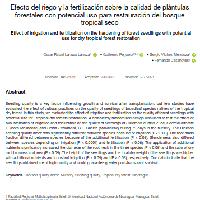Resumen
-
Seedling quality is a key factor influencing growth and survival after transplantation, but few studies have evaluated the effect of cultural practices on the quality of seedlings of broadleaf species natives of the tropical dry forest. In this study, we evaluated the effect of irrigation and fertilization on the quality of forest seedlings with potential use for tropical dry forests restoration. A completely randomized design was used to test the effect of two intensities of irrigation and fertilization on the quality of seedlings of Swietenia humilis Zucc, Cedrela odorata L. (both Meliaceae) and Ceiba Pentandra, C.F. Gaertn (Malvaceae) during 75 days in the nursery. The Dickson seedling quality index was significantly different between species because of irrigation (P < 0.05). The root mass fraction differed between species because of the additional fertilization (P < 0.05). Slenderness also differed between species depending on irrigation (P < 0.0001) and fertilization (P < 0.05). The application of additional nutrients significantly increased the diameter of the root neck in the three species (P < 0.05) and the ratio of dry root biomass and area (P < 0.05). The height of the seedlings and the total dry weight of the seedlings was higher with additional nutrients and constant irrigation (P < 0.05) and (P < 0.05), respectively. Our data indicate that the seedlings obtained are of high quality and could guarantee greater post-transplant survival.
- La calidad de plántulas es un factor clave que influye en el crecimiento y sobrevivencia luego del trasplante, pero pocos estudios han evaluado el efecto de las prácticas culturales sobre la calidad de especies latifoliadas nativas del bosque seco tropical. En este estudio, se evaluó el efecto del riego y la fertilización sobre la calidad de plántulas forestales con potencial uso para restauración de bosques secos tropicales. Se utilizó un diseño completamente aleatorizado para probar el efecto de dos intensidades de riego y de fertilización sobre la calidad de plántulas de Swietenia humilis Zucc, Cedrela odorata L. (ambas Meliaceae) y Ceiba Pentandra, C.F. Gaertn (Malvaceae) durante 75 días en vivero. El índice de calidad de plántulas de Dickson fue significativamente diferente entre especies debido al riego (P < 0,05). La fracción de masa de raíz difirió entre especies debido a la fertilización adicional (P < 0,05). La Esbeltez difirió entre especies en función del riego (P < 0,0001) y la fertilización (P < 0,05). La aplicación de nutrientes adicionales incremento significativamente el diámetro al cuello de la raíz en las tres especies (P < diámetro al cuello de la raíz en las tres especies (P <0,05) y la relación de biomasa seca de raíz y área (P < 0,05). La altura de las plántulas y el peso seco total fue mayor con nutrientes adicionales y riego constante (P <0,05 y P < 0,05 respectivamente). Nuestros datos indican que las plántulas obtenidas son de alta calidad y podrían garantizar una mayor sobrevivencia post trasplante.
